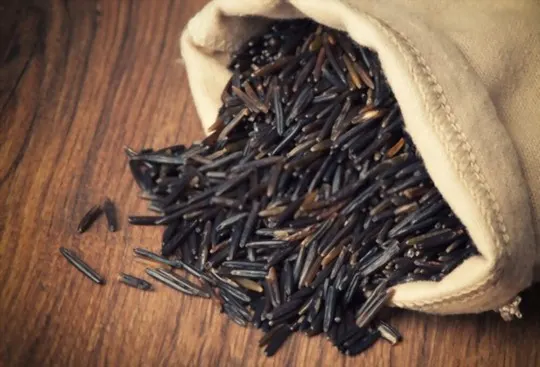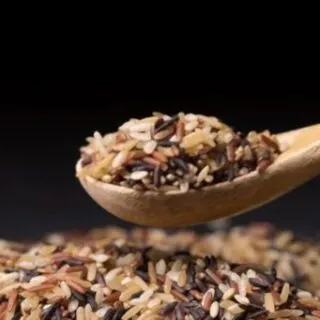If you’ve ever wondered what wild rice tastes like, you’re not alone.
If a grain can be as mysterious as it is delicious, then wild rice surely fits the bill.
Not to worry though – with this comprehensive guide we’ll break down the flavor profile of wild rice and give you a few tips on how to season it perfectly so that your meal stands out in all its glory.
From the crisp nuttiness to its mild sweet undertones, discover why wild rice should always be part of your weekly menu rotation!
What is Wild Rice?

Wild rice is a type of grass that is native to North America and has been valued for its nutritional benefits for centuries.
It has a nutty and earthy flavor and chewy texture that is distinct from regular rice.
Wild rice is a good source of protein, fiber, and essential minerals such as magnesium and zinc.
Its unique flavor makes it an excellent addition to salads, soups, and side dishes.
To cook wild rice, it is typically rinsed and then simmered in water or broth for about 45 minutes to an hour.
It can also be cooked in a rice cooker or pressure cooker for convenience.
Despite its name, wild rice is not technically a type of rice but rather a distant relative of Asian rice varieties.
To enhance the nutty flavor of wild rice, try toasting it in a dry skillet before cooking.
What Does Wild Rice Taste Like?

Wild rice is an aquatic grass that grows in shallow lakes, rivers, and other water bodies.
It has slender, black-brown grains and a rich, nutty flavor.
Wild rice has a firmer texture than regular rice and a chewy outer layer.
Its flavor is earthy and nutty, with a slight herbal taste.
Wild rice is often described as having a smoky, roasted flavor, which makes it a perfect complement to a variety of dishes.
As a whole-stem grain, the texture of wild rice is more chewy and satisfying than regular rice.
Some culinary experts describe the overall taste like a nutty brown rice, a little sweet and savory, and maybe even a bit grassy or herbaceous.
The versatility of wild rice makes it a great addition to a wide range of dishes.
Make sure to rinse the wild rice before cooking to remove any debris and improve the texture of the cooked grains.
Factors that Affect the Taste of Wild Rice

Wild rice is a popular grain that grows naturally in lakes and rivers.
Its taste is unique and earthy, with a slightly nutty flavor and a chewy, firm texture.
Several factors can affect the taste of wild rice, including harvesting time, cooking method, and storage conditions.
Here are some of the factors that impact the flavor of wild rice:
- Harvesting Time: Early harvested wild rice grain tends to have a softer texture and a milder flavor, while late harvested wild rice has a firmer texture and a more robust flavor.
- Cooking Method: The cooking method used affects the texture and taste of wild rice. Boiling or steaming wild rice in water or broth is the most common method, but it can also be toasted or fried for a nuttier taste and texture.
- Storage Conditions: Wild rice can quickly become rancid if not stored properly. To maintain the best flavor, store wild rice in an airtight container in a cool and dry place, away from direct sunlight.
How to Cook Wild Rice to Enhance its Flavor?

Wild rice is a long-grain aquatic grass that is native to North America.
Its flavor is earthy, nutty, and slightly sweet, making it a versatile ingredient in both sweet and savory dishes.
Here is how to cook wild rice to enhance its flavor:
- Rinse the wild rice in cold water until the water runs clear.
- In a large pot, bring 3 cups of water or broth to a boil.
- Add 1 cup of wild rice and reduce the heat to low.
- Cover the pot and let the rice simmer for 40-45 minutes or until the grains are tender and have split open.
- Drain any excess liquid and fluff the rice with a fork.
To enhance the nutty flavor of wild rice, try toasting it in a dry pan over medium heat for 5 minutes before cooking.
You can also cook the rice in vegetable or chicken broth instead of water for a richer flavor.
Pro tip- Add some sautéed garlic and onion to the rice while cooking for a deeper flavor.
Culinary Uses of Wild Rice
Wild rice is a type of aquatic grass that is native to North America, is not technically a rice grain but is often used as a grain.
Wild rice has a nutty, earthy flavor and a chewy texture that sets it apart from other grains.
Here are some culinary uses of wild rice:
- Salads: Wild rice makes a hearty and flavorful addition to salads. It pairs well with vegetables, fruits, nuts, and seeds.
- Soups: Wild rice can be added to soups or used as a base for creamy soup recipes. Its chewy texture adds a satisfying bite to the soup.
- Stuffings: Wild rice can be used as a stuffing for poultry, vegetables or as a side dish for thanksgiving. Its nutty flavor complements the savory tastes of the stuffing.
- Side dishes: Wild rice makes a versatile side dish, it can be flavored or served plain. It goes well with a variety of main dishes such as chicken, fish, or beef, making it a perfect substitute for other grains or carbs.
Pro tip: Wild rice takes longer to cook than other types of grains, and it requires more water to fully absorb.
So, cooking wild rice in a rice cooker gives it a perfect and consistent texture.
Is Wild Rice Healthy?

Wild rice is a nutrient-dense whole grain that is a great addition to any diet.
It is technically not rice but the seeds of aquatic grass.
The flavor of wild rice is nutty, earthy, and slightly chewy, making it a delicious alternative to regular rice.
Here are some health benefits of wild rice:
- High in protein: Wild rice is an excellent source of plant-based protein, making it a great option for vegetarians and vegans.
- Rich in antioxidants: Wild rice contains anthocyanins, which are antioxidants that can protect against cellular damage and reduce inflammation in the body.
- Good for digestion: The high fiber content in wild rice can aid digestion and prevent constipation.
- Low in calories: Wild rice is lower in calories than many other grains, making it a good option for those trying to manage their weight.
Where to Buy Wild Rice and How to Store It?

Wild rice is a type of grain that is known for its nutty and earthy flavor and chewy texture.
It is often enjoyed as a standalone dish or used as a base for salads and soups.
If you’re wondering where to buy wild rice and how to store it, there are a few tips to keep in mind.
Where to buy wild rice: You can find wild rice at most grocery stores, health food stores, and online marketplaces.
Look for packages that are labeled “100% wild rice” to ensure that you’re getting a high-quality product.
How to store wild rice: Store wild rice in an airtight container in a cool, dry place, such as a pantry or cupboard.
It can last for up to two years if stored properly.
Before cooking, rinse the rice thoroughly in cold water to remove any debris or dirt.
Then, cook it using your preferred method, such as simmering it on the stovetop or in a rice cooker.
Conclusion
In conclusion, wild rice is a nutrient-dense grain that is native to North America, with a unique texture and flavor profile that sets it apart from other rice varieties.
Wild rice has a nutty and earthy taste, with a chewy and slightly crunchy texture.
It is a great source of protein, fiber, and essential minerals such as magnesium, zinc, and folate.
Whether used in soups, salads, or as a side dish, wild rice adds a subtle and delightful flavor to any meal.
So next time you’re looking for a healthy and delicious alternative to white rice, wild rice is undoubtedly worth a try.

What Does Wild Rice Taste Like? A Comprehensive Guide
Ingredients
- Wild rice
- Ingredients from your selected recipes
Instructions
- Select ingredients that work well together.
- Use a recipe or method that will enhance their natural taste.
- Taste and adjust the recipe as needed to achieve the desired flavor.

Carrie is a food writer and editor with more than 15 years of experience. She has worked for some of the biggest names in the food industry, including Bon Appétit, Food & Wine, and Martha Stewart Living.
As the Editor in Chief of IntroChicago.com, Carrie oversees all of the content on the site. She also manages the team of contributing writers and editors, who help to create delicious recipes, helpful tips, and informative articles that you’ll find on the site.
A native of the Chicago area, Carrie is passionate about all things food. She loves trying new restaurants and experimenting with new recipes in her kitchen. She’s also a graduate of the Culinary Institute of America, so she knows a thing or two about food!
